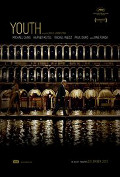
Directed by
Paolo Sorrentino
123 minutes
Rated M
Reviewed by
Chris Thompson

Youth
Synopsis: Retired composer/conductor, Fred Ballinger (Michael Caine) and veteran film director Mick Boyle (Harvey Keitel) are two lifelong friends on vacation in a luxurious spa hotel at the foot of the Swiss Alps. While Mick works with a group of young writers on what may be his final film, Fred is approached by an emissary of Queen Elizabeth II to conduct Sumi Jo singing his renowned Simple Songs #3 for Prince Phillip’s birthday. But he is determined that the piece will never be performed again. In addition to Ballinger’s daughter Lena (Rachel Weisz) who has just been dumped by Boyle’s son Julian (Ed Stoppard) – for Paloma Faith playing herself no less! - the other guests at the hotel include actor, Jimmy Tree (Paul Dano), emphysemic and obese retired soccer star, Diego Maradona (Roly Serrano) and Miss Universe (Madalina Diana Ghenea). In between conversations about their lives and their careers, Ballinger and Boyle observe the tribulations of their children and interact with other guests at the resort.Forget the synopsis. It’s just an excuse for Sorrentino to explore a raft of ideas that are vastly more interesting and meaningful than the narrative. As such, the follow up to his 2013 Oscar winning film, The Great Beauty is a masterwork of glorious imagery and reflective and moving moments that explore the nature of aging and the perspective that a lifetime can give to both the joys and the follies of youth, whether they be those personally experienced, or those observed in others. But beyond the ideas evoked in its title, Youth also invites us to consider how much we struggle with the idea of letting go, whether that be of things we hold onto out of a lifetime of habit – such as the Ballinger and Boyle’s ongoing argument about a girl from their youth who Ballinger might have loved and who Boyle might have slept with, although he can’t quite remember – or those things that the failures of the body and mind insist that we relinquish – such as the wistful look that the fat and wheezing Maradona gives to a lone tennis ball sitting on the court. Later there is a beautiful scene of Maradona repeatedly kicking that tennis ball into the wide blue sky as though he is back in the heyday of his soccer career. But is it real or is it a fantasy?
The question of real or fantasy comes up a lot. There are definite moments of fantasy such as Ballinger crossing paths with Miss Universe in St Mark’s Square as Venice slowly sinks into the sea, or Boyle confronted by the simultaneous appearance of all the main female characters he has created over the years. But there are also surreal moments that may or may not be fantasy. There is an inspired scene where Ballinger conducts the natural world on a nearby hillside dotted with grazing cows. It starts slowly with the cowbells and eventually introducing birdsong and the wind into the symphony. Or the long line of shuffling bodies draped in towels, queuing for the spa. It is visually striking but somehow other worldly. Moments like these made me wonder, at times, whether the whole place was really some kind of strange limbo world between life and death, between youth and old age. But then, aren’t we always caught between these two extremes. It’s how far we are along the timeline that makes the difference to what we understand and how we see the world.
The representation of actual youth is as important to the film as the roles played by the aging actors. There is a point where Ballinger encounters a young violinist (Leo Artin) who is practicing Simple Songs #3 and reveals that despite being made to practice it, he finds the piece to be beautiful. Later, Jimmy Tree who has been bemoaning that fact that out of all his serious acting work it’s really only his voicing of a robot character that has made him famous, meets a young girl who surprises him by recognising him for his lesser known roles. In these moments, Sorrentino allows for the possibility that the works these creative minds count as important, not just popular, might not be entirely forgotten by the younger generation, that they will matter after their creators are gone.
Caine and Keitel are sublime in their roles, resisting the temptation to overplay and allowing the gravitas of their actual age and the power of the film as a whole to underpin the subtlety of their performances whilst the supporting cast, including a marvellously hyperbolic cameo from Jane Fonda, are all equal to the leads. The standout for me, though, is the young masseuse (Luna Zimic Mijovic) whose supple hands manipulate the aging, flabby, wrinkled flesh of the older bodies and who we later glimpse alone in her room, dancing as free as we might imagine the guests wish they could still be.
The film is beautifully lit and shot by Luca Bigazzi who also shot The Great Beauty (of course the fabulous location helps too) and the eclectic mix of songs and music, some performed live, is superbly augmented by David Lang’s original compositions including Ballinger’s Simple Songs #3 and the exquisitely haunting Just (after Song of Songs).
Youth is a wonderful film - there is wonder in its visual richness but, more than that, there is wonder in the ideas it explores. The resonances of this film stayed with me for days afterwards, compelling me to consider and reconsider what it has to say. It may have come late in the year’s releases, but for my money, it was well worth the wait.

Want more about this film?


Want something different?




